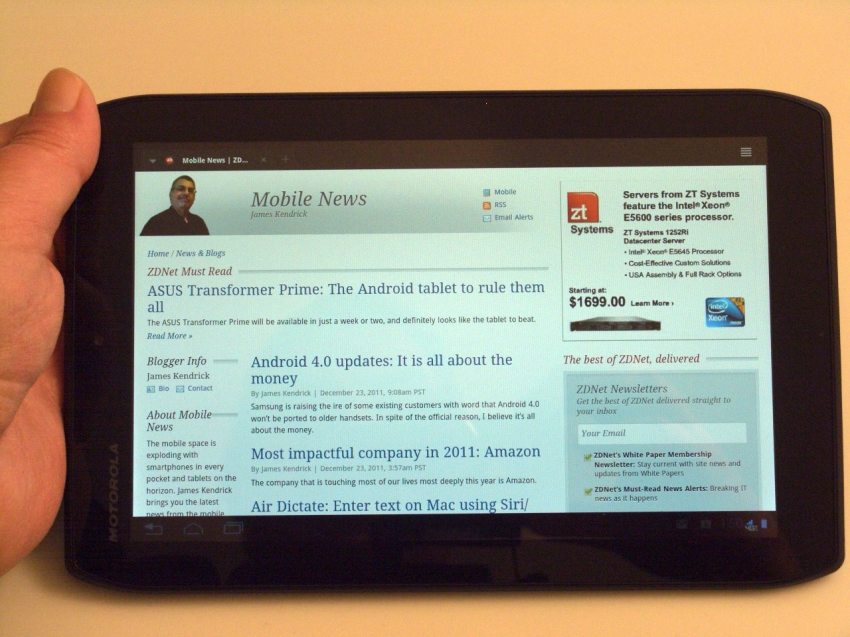Motorola DROID XYBOARD 8.2, 10.1 hands-on review


Motorola DROID XYBOARD 8.2 and XYBOARD 10.1 with 4G LTE on Verizon
| Image Gallery: Both the XYBOARD 8.2 and XYBOARD 10.1 pose for the camera | ||||||
- CPU: 1.2 GHz dual-core
- Display: IPS, 1280x800, 8.2-inch or 10.1-inch
- OS: Android 3.2 Honeycomb
- Cameras: 1.3MP front, 5MP rear, auto-focus, flash
- Storage: 16GB as reviewed
- Network: 4G LTE
- Connectivity: Wi-Fi, Bluetooth
- Ports: microUSB, HDMI-out
- Battery: XYBOARD 8.2: 3960 mAh Li Ion; XYBOARD 10.1: 7000 mAh Li Ion
- Dimensions: 253.9 x 173.6 x 8.80 mm (XYBOARD 10.1); 216 x 139.8 x 8.99 mm (XYBOARD 8.2)
- Weight: XYBOARD 10.1: 603 grams; XYBOARD 8.2: 390 grams
DROID XYBOARD 8.2 impressions
While both the 10-inch and 8-inch tablets feature good Motorola construction and are comfortable to hold for long periods, I find myself drawn more to the smaller of the two. The XYBOARD 8.2 is not physically much bigger than 7-inch tablets I have used, and the extra 1.2 inches of display is really nice given the high resolution of the screen. This tablet is a great ebook reader due to this gorgeous display.
I find I use the XYBOARD 8.2 mostly in portrait orientation, especially for web browsing. Again, the extra screen real estate compared to tablets like the original Galaxy Tab and the Kindle Fire makes it possible to read entire web pages without much zooming.
DROID XYBOARD 10.1 impressions
The larger sibling of the new DROID XYBOARD family is much improved over the original Motorola XOOM. While the XOOM didn't impress me at all, the XYBOARD 10.1 shows that Motorola set out to address most concerns about the original tablet. The XYBOARD 10.1 feels great in the hand, and the display is really nice.
Like the smaller model, the XYBOARD 10.1 is comfortable to use for extended periods which is important for tablets. Auto-rotation of the screen is smooth when switching from portrait to landscape, and overall performance is good. The hardware components used in both tablets are acceptable but don't push the envelope like the upcoming quad-core processors.
The cameras in both tablets are OK, but nothing to write home about. I don't use tablet cameras much as a rule, and these won't entice me to change that. Both feature front cameras for video calling, which work as expected.
The special feature found in the XYBOARD 10.1 that is missing from the smaller model is the inclusion of an active pen for note-taking and drawing. The pen ships in the box with the 10.1, and includes a pen pouch with a pocket clip so prevent losing the pen. The pen works with an app that makes it easy to make ink notes on the fly, and also works with Evernote. The integration with Evernote doesn't work as well as it does on the HTC Flyer, the other tablet with pen support. The pen functionality is not something I would use much as implemented.
Cut to the chase
Motorola made a design choice with both XYBOARD tablets that is annoying. Both tablets have the power button next to the volume button, located on the back of the slate. These buttons are indented, and since they are on the back where you can't see them, they are hard to operate by touch. I find myself constantly turning the tablet over to adjust the volume to turn the tablets on/off.
While both the XYBOARD 8.2 and XYBOARD 10.1 are nice tablets, the pricing is really high for what you get. Having 4G LTE connectivity is really nice in practice, but buying one of these tablets with a 2-year contract will set you back $379 or $479 for the 8 and 10-inch model, respectively. That's awfully high for a long commitment on top of the purchase price.
Verizon also offers both models without a contract, but that pricing is a staggering $599.99 and $699.99 for each. That lets you go month-to-month with the data plan, but Verizon charges a reconnect fee if you turn it off and on as needed. It is going to be hard to be competitive with this pricing, even though both tablets are nice Android tablets with LTE connectivity.